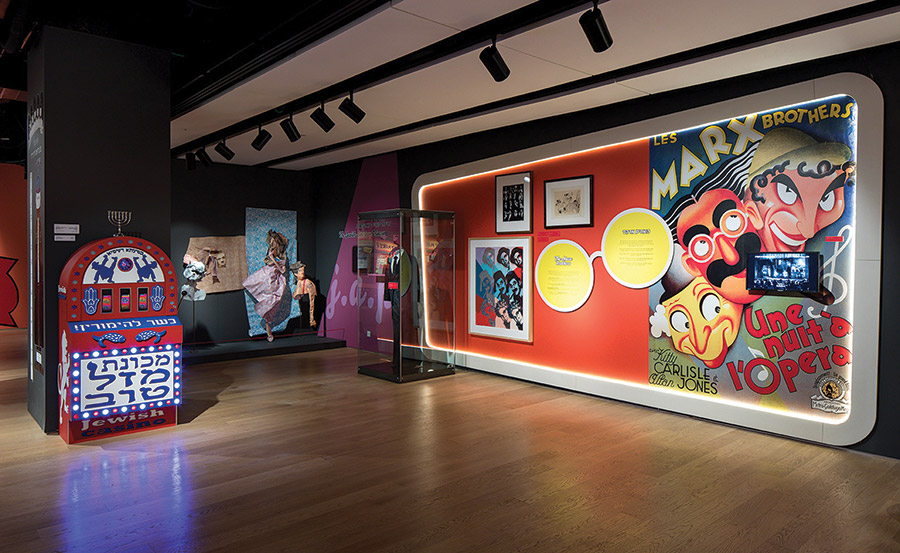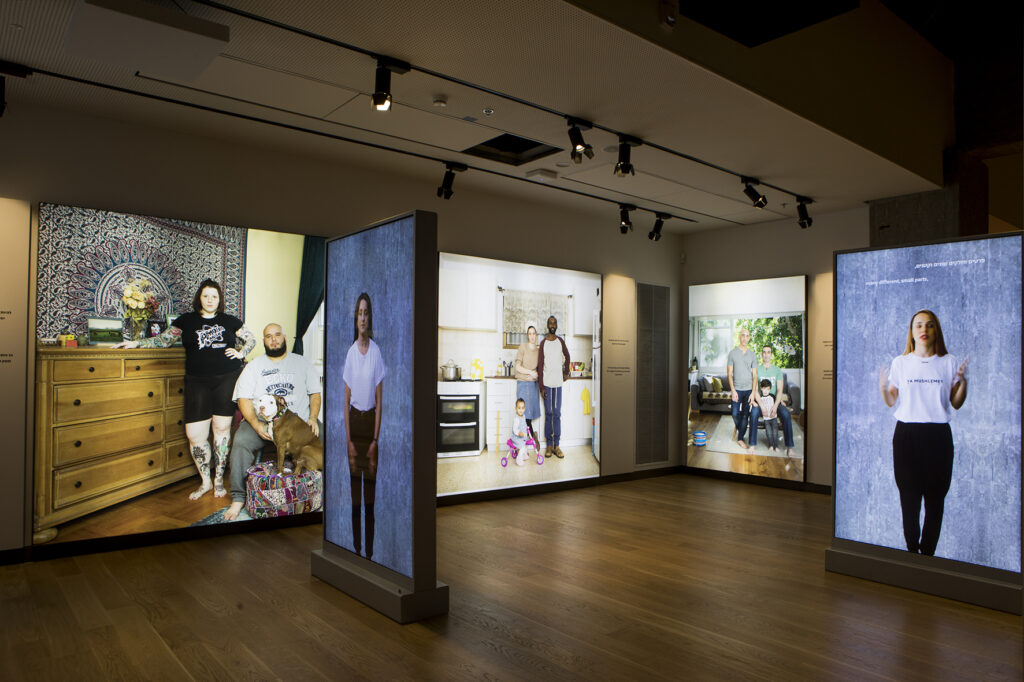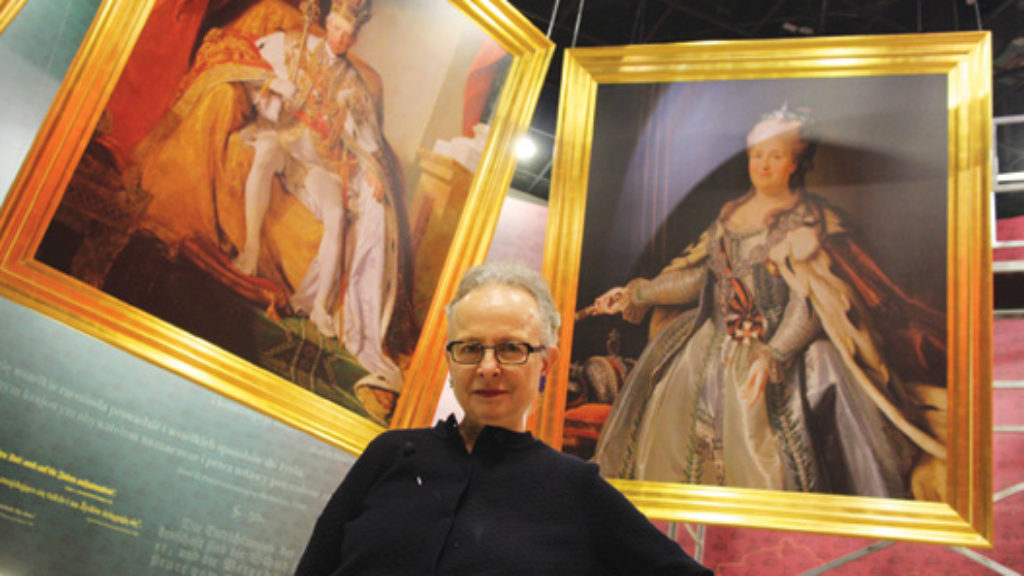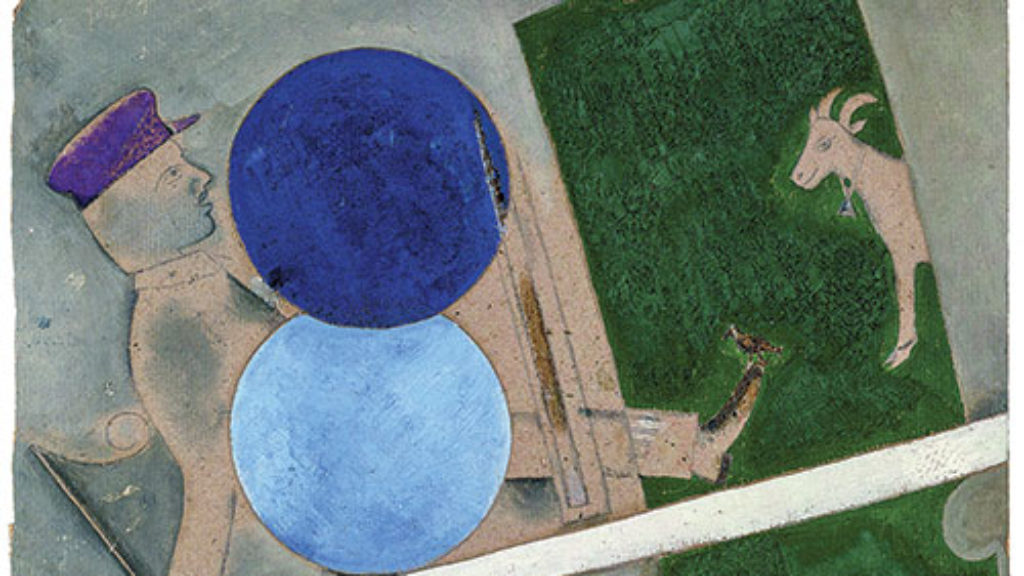Of Synagogues and Seinfeld
In March, the Tel Aviv Jewish museum formerly known as the Nahum Goldmann Museum of the Jewish Diaspora(or Beit Hatfutsot) reopened after a ten-year, $100 million renovation. Now called ANU—Museum of the Jewish People, it offers a cheery, inclusive vision of Jewish peoplehood.
The old Beit Hatfutsot museum was a familiar site, with its 1970’s architecture and iconic images: the comic illustration of the Jewish family tree, with offshoots across the Ashkenazi and Sephardi worlds; realistic reproductions of synagogues from across the globe; and a dramatic, illuminated multifloor memorial to victims of antisemitism that ushered visitors from one level to the next. ANU, by contrast, is a thoroughly twenty-first-century museum whose exhibits begin in the present and move backward through time. Upon entry, visitors are faced with realistic, life-size projections of actual Jews, mostly from Israel and the United States, explaining what Judaism means to them. Vibrant floor-to-ceiling photographs that show a spectrum of Jewish families are interspersed with quotations by figures such as Jacques Derrida, “I am one of those Marranos who no longer say they are Jews even in the secret of their own hearts,” and Austrian writer Vicki Baum, “To be a Jew is a destiny.” The effect is that of a conversation between competing, sometimes contrasting voices chattering away and trailing off with some interesting thoughts, as well as platitudes, about their sense of what it means to be Jewish.

The creative, tongue-in-cheek comic illustrations are still there, but it must have taken a veritable army of artists and illustrators to create the museum’s dynamic new visual scheme—at 72,000 square feet, it is now the largest Jewish museum in the world. The familiar synagogues are incorporated into an independent exhibition on Jewish prayer called Hallelujah! Assemble, Pray, Study—Synagogues Past and Present. One can use touch screens to “build your own synagogue” or get sucked down the rabbit hole (as I did) of listening to recordings of traditional piyyutim by modern Israeli singers as well as lesser-known versions from far-flung communities in the Middle East, Africa, and Asia. The towering Yizkor memorial is gone, and the new museum’s designers clearly chose to downplay oppression in favor of Jewish agency and creative contributions to their local cultures. An engaging animated film called Jewish Voyages is projected on a wide panoramic frame surrounding a digitized world map. The film begins and ends with a bustling scene from Ben Gurion Airport and a quote about how being Jewish means knowing how to pack quickly. Elsewhere, another entertaining film created for the museum recounts the influence of the Bible on American civilization through the prism of a Larry David–lookalike and his wife, hosting their children for a Passover Seder on New York’s Upper West Side. Spring was an interesting time to open a museum that argues for the interconnectedness of the Jewish world since it was virtually impossible for non-Israelis to enter the country. While considerable efforts were made to update the museum to reflect the diversity and complexity of modern diaspora Jewish communities, especially in the United States, one senses that some of the images and sounds might already be obsolete. Responses to COVID-19 have transformed contemporary Jewish life, particularly in the non-Orthodox world, in a way that may have ripple effects well into the future. One certainly cannot fault the museum for any of this, and if liberal synagogues maintain some of their new virtual, dial-in qualities, perhaps the museum exhibits will become even more important as testimony to a way of life that is now irrevocably altered.
And yet, despite it all, when I wandered through the museum on a random Wednesday morning in April, it was packed. The visitors were mainly Hebrew-speaking Israelis, in tour groups and alone, taking in sights such as Leonard Cohen’s guitar and Ruth Bader Ginsburg’s lace collar or absorbing thoughts about Jewish identity from life-size digital projections of Brooklyn haredi judge Ruchie Freier and Sharon Brous, the noted liberal rabbi from Los Angeles. I couldn’t help but laugh when I watched two secular Israelis discussing the difference between American Modern Orthodoxy and Israeli religious Zionism. (The graphic that gave rise to this discussion featured two similar pictures of the same woman; she’s wearing a baseball cap in the American picture and a fabric turban in the Israeli one.)
It was hard to find a free spot to watch the music video in which Sha’anan Streett of the celebrated Israeli band Hadag Nahash performs an original Hebrew song depicting the contributions of Jews to nearly every field: “Amedeo Modigliani who painted women with such long necks, Annie Leibovitz who changed photography (tzilum), Jerry Seinfeld who wrote a show about nothing (klum).” Unlike Adam Sandler’s legendary Hanukkah song, it’s unlikely that the singer has heard of half the people he sings about; the list includes philosophers, economists, and once famous though now obscure actors and filmmakers from Eastern Europe and the Arabic-speaking world. Yet even that disconnect was part of the fun.
In a film area titled My Hero, contemporary artists reflect on the Jewish figures who inspire them. For Nicole Krauss, an American Jewish writer, the work of Philip Roth is deeply Jewish in its celebration of uncertainty and doubt, even when it challenges Judaism itself. For Tomer Yosef, a Yemenite Israeli musician of Balkan Beat Box fame, the Beastie Boys were awesome. As a young Bnei Akiva girl, Israeli photographer Vardi Kahana was inspired by a Richard Avedon photograph of an haute couture model standing between elephants. The area of the museum devoted to great Jewish writers features a quote from Marcel Proust followed by a question in bold that I have not seen in an American Jewish museum before: “What is Jewish here?” The answer, we are permitted to consider, may be not very much at all.
ANU is a more lighthearted museum than its predecessor, but it’s not as kitschy as it might sound, precisely because it is in Israel. Visitors to the galleries of the Jewish Museum in New York can absorb its rich offerings and simply forget that Judaism even exists as a religion apart from its remarkable cultural impact. Here, one has the unmistakable sense that the designers of ANU, and most of its current visitors, have a shared understanding of what Judaism is, even if they might not agree on all its meanings and implications.
When you walk into the museum from its entrance at the gate to Tel Aviv University, you pass on the right a large construction site for the future nanoscience and nanotechnology building, sponsored by the Russian multibillionaire Roman Abramovich, currently Israel’s wealthiest citizen. Despite ANU’s remarkable features and thoughtful design, it’s clear that the energy of modern Israel has more to do with technological innovation than diasporic history. One wonders how soon it will be until the new museum building starts to have the charming, dated look of Beit Hatfutsot. Just as the museum marvels at the Jewish ability to adapt and redirect, maybe even its own cultural Jewish focus will one day start to feel outdated as well.

Nevertheless, for now, there’s plenty there to enjoy. One highlight is the new museum’s first temporary exhibit: Let There Be Laughter—Jewish Humor Around the World. It opened in March 2018 when much of the rest of the museum was still under construction, and it manages the difficult balance of reflecting on the nature of Jewish humor while being actually hilarious. The exhibit features realistic reproductions of Seinfeld’s Manhattan apartment, an endless loop of Jewish takes on Christmas songs from South Park and the like, and a kitchen-shaped shrine to Jewish mother jokes. There’s also a sizable Israeli section, with full-size replicas of memorable characters like the choleric Russian cashier from Israel’s version of Saturday Night Live, Eretz Nehederet.

My favorite installment was a lifelike replica of a bar, in which one can sit and enjoy an hour-long stream of contemporary Israeli stand-up comics projected on the wall. After more than a year of COVID lockdown, it felt nice to sit in a bar, even a fake one. The jokes poked at different areas of life in Israel: school, the army, quite a bit about Jewish religious life, and the various ethnic subgroups that comprise Israel’s rich culture. One comedian of Ethiopian descent described what happened when the Eritrean and Sudanese migrants began coming to Israel: “Suddenly we were Ashkenazim!” And everyone got an “upgrade”: “The Yemenites were now Swedes, and the Moroccans, well the Moroccans started to think they were the queen of England. . . . May I have some couscous with my tea?” he deadpanned in perfectly British-accented English.
Sitting there, in between bouts of laughter, I pondered whether a museum could ever capture the vibrancy of a people in the same way that comedy can. If ANU aims to tell the ongoing story of the Jewish people that reflects the immensely dynamic Israeli Jewish culture that surrounds it, it will have to stay on its toes.
Comments
You must log in to comment Log In
Suggested Reading

POLIN: A Light Unto the Nations
How is it that the largest public building to go up in Poland since that country regained its freedom, the first museum to tell the story of Poland from beginning to end, goes by the name of POLIN?

Art Over Vitebsk
After the revolution, Marc Chagall—somewhat implausibly—became plenipotentiary for the affairs of art in the province of Vitebsk. Against all probability, the avant-garde bloomed in a provincial Russian city dominated by Jewish culture.

A Measure of Beauty
The Israeli hip-hop band Hadag Nahash blend the many strata of Hebrew language.
Freedom Riders
There is nothing subtle about the theme that runs throughout Philadelphia's National Museum of American Jewish History.
Shai Secunda
Great, fresh review of what sounds like a great and fresh museum! I just have a one small criticism: Rindner's assumption about Hadag Nachash's "influential Jews" rap produced for ANU, where she writes that "unlike Adam Sandler’s legendary Hanukkah song, it’s unlikely that the singer has heard of half the people he sings about; the list includes philosophers, economists, and once famous though now obscure actors and filmmakers from Eastern Europe and the Arabic-speaking world."
As Azzan Yadin wrote in a review for these pages way back in Fall 2010, Hadag Nachash is the most sophisticated Hip-Hop band on the Israeli scene. Having listened to the song, it's clear that Shaanan Street knows exactly what he's talking about, from the first name mentioned - the French-Jewish public intellectual, Bernard-Henri Lévy (articulated properly, without pronouncing the "H") - to the final figure - the Canadian-Jewish poet and singer, Leonard Cohen. Indeed, the difference between the American comedian, Adam Sandler's, funny but uninspiring Jewish celebrity list, and the Israeli rapper, Shanaan Street's, cosmopolitan song may be more broadly instructive about differences between popular Jewish culture in Israel and America.
Sarah Rindner
Fair enough! Thanks so much for the feedback, and after this comment I am going to give the music and lyrics of Hadag Nachash a closer look.
gershon hepner
TO BE A POET
A poet is a metaphor
for being Jewish: he defies
all boundaries as he looks for more
than meets prosaic gentile eyes,
telling secrets like ones a Marrano
would hide inside his heart but might,
poetically, extremely piano,
encrypt in verse he’d dared to write.